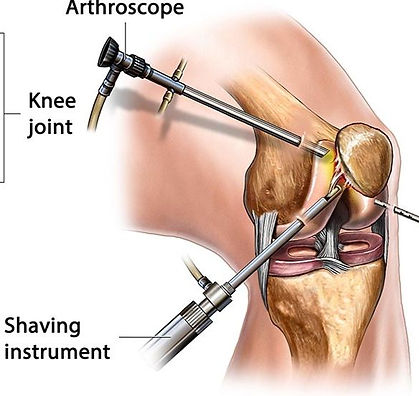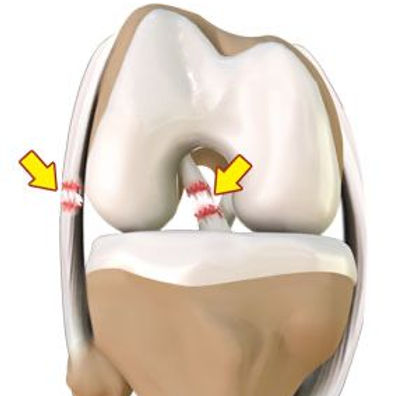Book an appointment with Bihar's leading Sports Injury Specialist & Orthopaedic Surgeon
Consultant Orthopedics & Sports Injury Surgeon

Knee Treatment and Surgery
.jpeg)
Total Knee Replacement (TKR)
Total Knee Replacement (TKR), also known as knee arthroplasty, is a surgical procedure designed to relieve pain and restore function in severely damaged knee joints. This elective surgery is often recommended for individuals suffering from advanced osteoarthritis, rheumatoid arthritis, or other conditions that cause significant joint deterioration. During the procedure, the damaged portions of the knee joint are replaced with artificial components, typically made of metal and plastic, to provide improved joint movement and alleviate pain.
TKR aims to enhance mobility, reduce discomfort, and improve the overall quality of life for individuals grappling with debilitating knee issues. Rehabilitation and postoperative care are crucial components of the recovery process, ensuring patients regain strength, flexibility, and independence in their daily activities.
Arthroscopic Knee Surgery
Arthroscopic Knee Surgery is a minimally invasive surgical procedure used to diagnose and treat various knee joint conditions. During this procedure, a small camera, called an arthroscope, is inserted through tiny incisions around the knee, allowing orthopedic surgeons to visualize the internal structures in real-time.
Arthroscopic surgery is commonly employed for repairing torn ligaments, removing damaged cartilage, treating inflammation, and addressing other knee injuries. The benefits of arthroscopy include smaller incisions, reduced postoperative pain, faster recovery times, and less scarring compared to traditional open surgery. This technique enables surgeons to precisely target and address specific issues within the knee joint, promoting quicker rehabilitation and an earlier return to normal activities for patients.


Arthroscopic Meniscus Repair
Arthroscopic Meniscus Repair is a specialized and minimally invasive surgical procedure aimed at treating injuries to the meniscus, a crucial cartilage in the knee joint. Utilizing an arthroscope—a small, flexible tube with a camera—surgeons make small incisions to access the knee joint. The arthroscope allows for clear visualization of the damaged meniscus. During the procedure, the torn or injured portion of the meniscus is either removed or repaired using small instruments inserted through additional incisions.
This approach minimizes trauma to surrounding tissues, resulting in reduced postoperative pain, quicker recovery, and enhanced overall outcomes. Arthroscopic Meniscus Repair is commonly recommended for individuals with meniscal tears, helping restore knee function and alleviate pain while preserving as much of the natural meniscus as possible.
Arthroscopic Ligament Surgery
Arthroscopic Ligament Surgery is a minimally invasive surgical procedure employed to diagnose and treat injuries to the ligaments within a joint, most commonly in the knee. Using an arthroscope—a small, flexible tube with a camera—surgeons make small incisions to access the joint. This allows for a detailed view of the damaged ligaments. Whether addressing a torn anterior cruciate ligament (ACL) or other ligament injuries, surgeons use specialized instruments to repair or reconstruct the affected ligament.
The benefits of this arthroscopic approach include reduced surgical trauma, smaller incisions, faster recovery, and a diminished risk of complications. Arthroscopic Ligament Surgery is a preferred method for many patients seeking effective ligament repair while minimizing postoperative discomfort and facilitating a quicker return to normal activities.


PCL And Multiple Ligament Injuries
Posterior Cruciate Ligament (PCL) and Multiple Ligament Injuries represent complex traumas affecting the ligaments within a joint, often observed in the knee. These injuries typically result from high-impact events, such as sports injuries or accidents, causing damage to multiple ligaments, including the PCL.
Evaluation of PCL and multiple ligament injuries involves a thorough assessment to determine the extent of damage and formulate an appropriate treatment plan. Surgical intervention may be recommended to address torn or ruptured ligaments, often utilizing advanced techniques like arthroscopy for a minimally invasive approach. The goal of surgery is to restore stability to the joint by repairing or reconstructing the damaged ligaments.
Reconstructive Knee Surgery
Reconstructive Knee Surgery is a surgical procedure aimed at restoring function and stability to the knee joint, often following injury or damage. This comprehensive intervention typically involves the repair or reconstruction of ligaments, tendons, or other structures within the knee. Common scenarios for reconstructive knee surgery include injuries to the anterior cruciate ligament (ACL), posterior cruciate ligament (PCL), or meniscus, as well as cases of chronic joint instability or degenerative conditions.
Surgeons may employ various techniques, including arthroscopy, to minimize surgical trauma and promote quicker recovery. In cases of ligamentous injuries, grafts or substitutes may be used to reconstruct the damaged tissue. The ultimate goal of reconstructive knee surgery is to enhance joint stability, alleviate pain, and enable individuals to regain optimal function and mobility.

